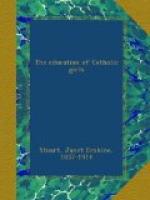The bad effect of being either self-taught or conventional is exclusiveness; in one case the personal bias is too marked, in the other the temporary aspect appeals too strongly. In the education of taste it is needful that the child should “eat butter and honey,” not only so as to refuse the evil and choose the good, but also to judge between good and good, and to know butter from honey and honey from butter. This is the principal end of the study of art in early education. The doing is very elementary, but the principles of discernment are something for life, feeding the springs of choice and delight, and making sure that they shall run clear and untroubled.
Teaching concerning art which can be given to girls has to be approached with a sense of responsibility from conviction of the importance of its bearing on character as a whole. Let anyone who has tried it pass in review a number of girls as they grow up, and judge whether their instinct in art does not give a key to their character, always supposing that they have some inclination to reflect on matters of beauty, for there are some who are candidly indifferent to beauty if they can have excitement. They have probably been spoiled as children and find it hard to recover. Excitement has worn the senses so that their report grows dull and feeble. Imagination runs on other lines and requires stimulants; there is no stillness of mind in which the perception of beauty and harmony and fitness can grow up.
There are others—may they be few—in whose minds there is little room for anything but success. Utilitarians in social life, their determination is to get on, and this spirit pervades all they do; it has the making of the hardest-grained worldliness: to these art has nothing to say. But there are others to whom it has a definite message, and their response to it corresponds to various schools or stages of art. There are some who are daring and explicit in their taste; they resent the curb, and rush into what is extravagant with a very feeble protest against it from within themselves. Beside them are simpler minds, merely exuberant, for whom there can never be enough light or colour in their picture of life. If they are gifted with enough intelligence to steady their joyful constitution of mind, these will often develop a taste that is fine and true. In the background of the group are generally a few silent members of sensitive temperament and deeper intuition, who see with marvellous quickness, but see too much to be happy and content, almost too much to be true. They incline towards another extreme, an ideal so high-pitched as to become unreal, and it meets with the penalty of unreality in over-balancing itself. Children nearly always pull to one side or the other; it is a work of long patience even to make them accept that there should be a golden mean. Did they ever need it so much as they do now? Probably each generation in turn, from Solomon’s time onward,




